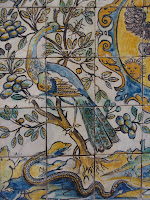The National Museum of glazed tiles is among the nicest Museums to be visited in Lisbon. The fact that it has been housed in the cloisters of the Convent of Madre de Deus, dating back to 1509 makes the visit even more interesting.
The decorative panels depict the evolutive stages of the glaze tile making since its introduction by the Moors through to the development of a so called Portuguese style.
The Manueline cloister walls are decorated with geometric tiles and the rooms around it display the glazed tiles by chronological age, the oldest being exhibited in the ground floor.
The central part of a huge 16th century panel of tiles representing the adoration of the shepperds is magnificent, so are many of the other tiles, whose motives vary immensely.
The 17th century tiles depicting hunting scenes are said to have been mostly decorated by artisans and not necessarily well reknown artists, though the artistry of some of them is worth being looked at.
The Church was finished during the16th century acording to the guide but it wasn't but much later that it was decorated, the sumptuous rococo retable having been added after the 1755 earthquake. All of its walls are covered in white and blue tiles and at times one has to walk inbetween the church stools to be able to admire some of them.
To thoroughly observe and absorb the beauty of the tile decorated upper rooms one needs time ...
Visiting it more than once does not diminish the impact it has on anyone who visits it, as there is always something "new" to look at ... a detail one may not have seen the first time around ... a room one may have seen in a haste ...
What seems to always sadden me is the fact that places like these are mostly visited by foreigners who do appreciate and value the things we as Portuguese should be proud of and ought to visit more often ...



















No comments:
Post a Comment